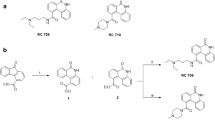Summary
A complex of novel and exceptionally potent antibiotics has been evaluated for antitumor activity in vitro and in vivo and characterized with regard to their ability to cause DNA strand scission. The major component, PD 114,759, was quite active against all in vitro tumor systems including the human tumors, MCF-7 breast, HCT-8 colon, and A549 lung and the murine tumors M16/c mammary, Lewis lung, Pan 02 pancreas and L1210 leukemia. ID50 values ranged from 2–57 pg/ml. In vivo this agent produced significant increases of host life spans in mice bearing L1210 leukemia, B16 melanoma and the M5076 sarcoma. Further, it inhibited growth of subcutaneous implants of the Ridgway osteogenic sarcoma by 80% and growth of the MX-1 human mammary xenograft by 90–95%. PD 114, 759, however, had no activity against the colon adenocarcinoma 11a or mammary adenocarcinoma 16c. Chinese hamster ovary cells exposed for 24 hours to concentrations of PD 114,759 ranging from 18 to 37 pg/ml accumulated in the S and G2 + M phases of the cell cycle with a corresponding decrease in G1. Higher concentrations of drug apparently stopped any progression through the cell cycle. PD 114,759 caused significant DNA single strand breaks in L1210 cells exposed for 1 hour to drug concentrations as low as 20 pg/ml and the frequency of these lesions increased in proportion to the drug concentration. A portion of these DNA breaks appeared to be associated with protein. In contrast, no double strand DNA breaks were detected at the highest drug concentration tested (100 pg/ml).
Similar content being viewed by others
References
Tunac JB, Graham BD, Mamber SW, Dobson WE, Lenzini MD: Potent antitumor antibiotic complex: PD 114,759, PD 115,028, PD 119,707, and PD 119,193. J Antibiot 38:1337–1343, 1985
Bunge RH, Hurley TR, Smitka TA, Wilmer NE, Brankiewicz AJ, Steinman CE, French JC: PD 114,759 and PD 115,028, novel antitumor antibiotics with phenomenal potency. I. Isolation and characterization. J Antibiot 37:1566–1571, 1984
Wilton JH, Hokanson GC, French, JC: The structures of the UV chromophoric fragments of the antitumor antibiotics, PD 114,759 and PD 115,028. J Chem Soc Chem Commun: 919–920, 1985
Finlay GJ, Baguley BC, Wilson WR: A semiautomated microculture method for investigating growth inhibitory effects of cytotoxic compounds on exponentially growing carcinoma cells. Anal Biochem 139:272–277, 1984
Baguley BC, Nash R: Antitumor activity of substituted 9-anilinoacridines-comparison of in vivo and in vitro testing systems. Eur J Cancer 17:671–679, 1981
Geran RI, Greenberg NH, MacDonald MM, Schumaker AM, Abbott BJ: Protocols for screening chemical agents and natural products against animal tumors and other biological systems. Cancer Chemother Rep 3:1–103, 1972
Corbett TH, Leopold WR, Dykes DJ, Roberts BJ, Griswold DP Jr, Schabel FM Jr: Toxicity and anticancer activity of a new triazine antifolate (NSC 127755). Cancer Res 42:1707–1715, 1982
In vivo cancer models, 1976–1982. In NIH publication # 84–2635, 1984
Tate EH, Wilder ME, Cram SL, Wharton W: A method for staining 3T3 cell nuclei with propidium iodide in hypotonic solution. Cytometry 4:211–220, 1983
Kohn WK, Ewig RAG, Erickson LC, Zwelling LA: Measurement of strand breaks and cross-links by alkaline elution. In: Friedberg EC, Hanawalt PC (eds): DNA repair. A laboratory manual for research procedures. Marcel Dekker, New York, 1981, pp 379–401
Bradley MO, Kohn KW: X-ray induced DNA double strand break production and repair in mammalian cells as measured by neutral filter elution. Nuc Acids Res 7:793–804, 1979
Tewey KM, Chen GL, Nelson EM, Liu LF: Intercalative antitumor drugs interfere with the breakage-reunion reaction of mammalian DNA topoisomerase II. J Biol Chem 259:9182–9187, 1984
Nelson EM, Tewey KM, Liu LF: Mechanism of antitumor drug action: poisoning of mammalian DNA topoisomerase II on DNA by 4′-(9-acridinylamino)-methanesulfon-manisidide. Proc Natl Acad Sci USA 81:1361–1365, 1984
Tewey KM, Rowe TC, Yang L, Halligan BD, Liu LF: Adriamycin-induced DNA damage mediated by mammalian DNA topoisomerase II. Science 226:446–468, 1984
Twentyman PR: Bleomycin-mode of action with particular reference to the cell cycle. Pharmac Ther 23:417–441, 1984
Iqbal ZM, Kohn KW, Ewig RAG, Fornace AJ: Singlestrand scission and repair of DNA in mammalian cells by bleomycin. Cancer Res 38:3834–3838, 1976
Huang CH, Mirabelli CK, Han Y, Crooke ST: Single-strand and double-strand deoxyribonucleic acid breaks produced by several bleomycin analogues. Biochemistry 20:233–238, 1981
Porvirk LF, Wabker W, Kohnlem W, Hutchinson F: DNA double-strand breaks and alkali-labile bonds produced by bleomycin. Nucleic Acids Res 4:3573–3580, 1977
Author information
Authors and Affiliations
Rights and permissions
About this article
Cite this article
Fry, D.W., Shillis, J.L. & Leopold, W.R. Biological and biochemical activities of the novel antitumor antibiotic PD 114,759 and related derivatives. Invest New Drugs 4, 3–10 (1986). https://doi.org/10.1007/BF00172009
Issue Date:
DOI: https://doi.org/10.1007/BF00172009



